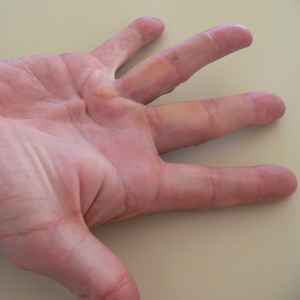Dupuytren’s Disease

First described in 1833 by Baron Guillaume Dupuytren, Dupuytren’s disease (DD) or Dupuytren’s Contracture is a progressive fibroproliferative disease of the palmar fascia and the most common inherited disorder of the connective tissue, with 5-25% prevalence in people of European descent, male:female ratio > 3:1. It is characterized by the initial development of myofibroblast-rich nodules, leading to the formation of abnormal cords in the palm of the hand. In a proportion of patients, the myofibroblasts cause contraction, leading to flexion contractures of the involved digits and subsequent functional impairment . Treatment options are limited. It is most commonly treated by surgical excision of the affected tissue, but with long rehabilitation rates and a high recurrence rate (>30% after 3 years), improved treatment strategies are warranted1, 2.
[1] Hart, M. G., and Hooper, G. (2005) Clinical associations of Dupuytren's disease, Postgrad Med J 81, 425-428.
[2] Ng, M., Thakkar, D., Southam, L., Werker, P., Ophoff, R., Becker, K., Nothnagel, M., Franke, A., Nurnberg, P., Espirito-Santo, A. I., Izadi, D., Hennies, H. C., Nanchahal, J., Zeggini, E., and Furniss, D. (2017) A Genome-wide Association Study of Dupuytren Disease Reveals 17 Additional Variants Implicated in Fibrosis, Am J Hum Genet 101, 417-427.



